Ssangyong Rexton long-term review
 Can this old-school 4x4 deal with some heavy-duty abuse? We’re about to find out
Can this old-school 4x4 deal with some heavy-duty abuse? We’re about to find out
Why we’re running it: To find out whether a big, separate-chassis, part-time all-wheel-drive SUV still has a place in the world
Month 5 - Month 4 - Month 3 - Month 2 - Month 1 - Specs
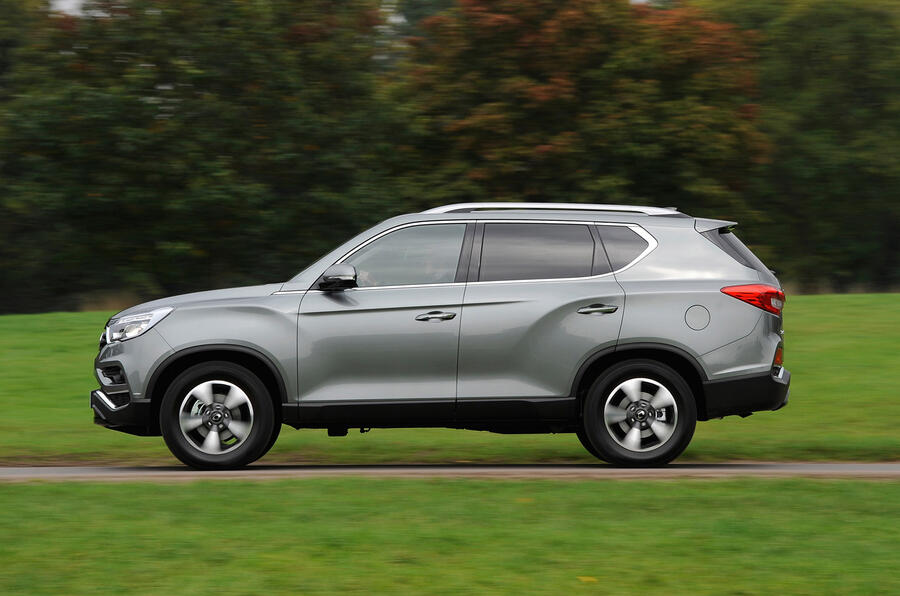
Life with a Ssangyong Rexton: Month 5
Almost time to say goodbye - 31st October 2018
Soon the Ssangyong will be gone, prompting thoughts about what I’ll most miss. One aspect struck me forcibly aboard my Rover 75 recently, and that’s the height of the Rexton’s driving position. The 75 isn’t especially low, but in the Ssangyong you feel like you’re flying at 30,000ft to the Rover’s 15,000ft. That makes traffic-snared journeys less dull because you see more.
Mileage: 8036
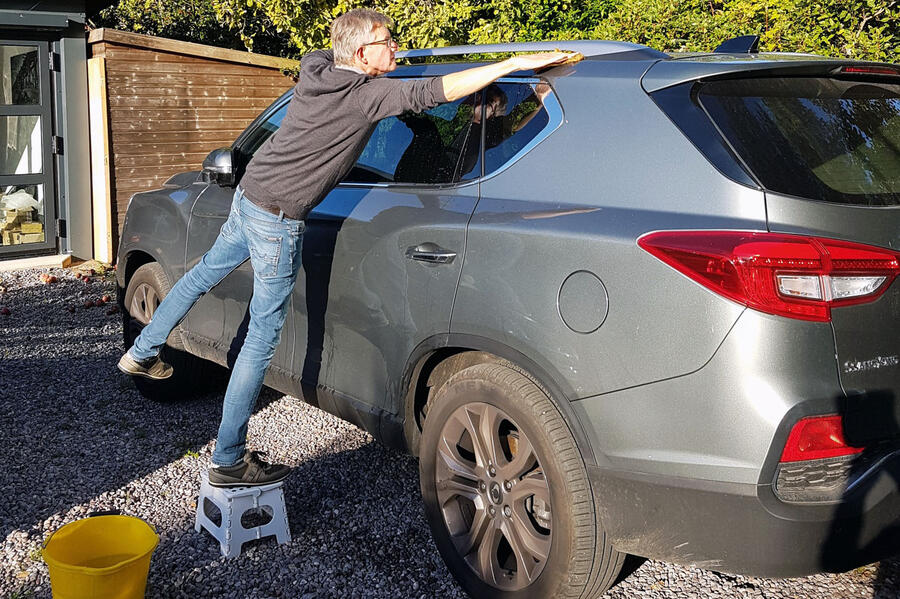
Can our T-Rexton be tamed outside of its natural habitat? - 17th October 2018
You wouldn’t normally call washing a car a project but, in the case of the Rexton, this activity is certainly a decent undertaking.
The first and very obvious challenge is the Ssangyong’s size; the second, which becomes apparent almost immediately afterwards, is that you will need to achieve some altitude if you’re even to see its roof, never mind give this veldt of steel the sponge and leather treatment. This is hardly the Rexton’s fault, of course: if you want a tall, capacious vehicle, then by definition it is going to be big. You just need to allow yourself a good couple of hours if you’re going to make a good job of it.
Meanwhile, the Rexton continues to not go wrong. In fact, a fault I’d previously logged, the infotainment’s inability to ingest my mobile’s address book, is down to operator error. You have to press a symbol on the screen to enable it to download your contacts. That the instruction book for the infotainment system is absent from the owner’s pack of this car is my excuse.
There’s no reason why the Rexton should go wrong, of course, but the absence of any faults is very pleasing, underlining both the robustness of its construction and the quality of its constituent materials.
True, a total mileage of around 7000 hardly constitutes a major durability trial, but the pattern so far bodes well for the next 70,000 miles, and far beyond. In fact, the Ssangyong service book extends to 26 services at 12,500 intervals, loosely implying a 325,000-mile service life. That probably isn’t impossible if it’s maintained correctly.
The mechanical soundness of the Rexton, in terms of durability if not finesse, the luxury ambience of its cabin and the long list of electronic driver aids and convenience features nevertheless continue to clash unavoidably with its inability to negotiate a typical British B-road without coming over all turbulent.
The huge 20in wheels and their tyres can’t help – their substantial unsprung weight sometimes causing mild shudder – but there’s more to its discombobulation than that: the suspension’s ability to absorb small to medium bumps is frequently overwhelmed. Given this light commotion, the Ssangyong’s directional stability is actually pretty good, and its urge to veer off line relatively limited.
Excellent steering helps: its old-school, fuel-squandering hydraulic assistance provides a consistent, well-judged and pleasingly liquid feel of a kind rarely found these days.
As you will have gathered, though, this is not a vehicle for hard charges down B-roads. Nor is it for hard charges out of side roads onto a busy main – the inside rear wheel lifting enough to spin if you need an urgent departure into the traffic flow.
That the Rexton’s rear end is less well planted than its front you’ll discover easily enough on wet roundabouts as things turn a little frisky. However, the ESP soon prevents you from presenting a wall of Ssangyong to the road ahead and at higher speeds it hangs on better than these slitherings might suggest. Depositing some heft in the boot helps too.
Musing on all this quite often leads you to imagine what a competitive vehicle the Rexton would be for the money if it had better suspension, and if you can get past the weird sculptures that are its front wings. Which you don’t have to view from inside, of course.
Love it:
VAST LOAD BAY Impressive, even with the rear seats up. You find yourself doing long-put-off jobs as a result.
Loathe it:
NO ‘RADIO’ HARD KEY Extra touchscreen prodding is therefore needed for a station search.
Mileage: 7171
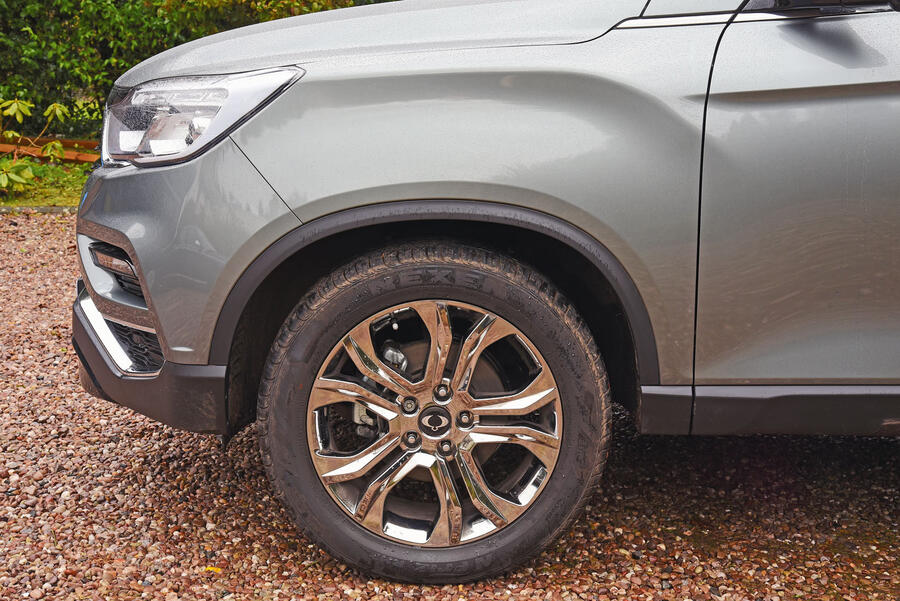
Elevation elation - 26th September 2018
“I love the seating position, its height and that you can see over hedges,” says my wife, who’s been driving the Rexton recently. “It doesn’t sound too much like a tractor,” she adds, its 2.2 diesel a pleasingly subdued companion. “It’s easy to load. But the turning circle isn’t great, and it’s bumpy over lumps that it shouldn’t be bumpy over.” Indeed.
Mileage: 6096
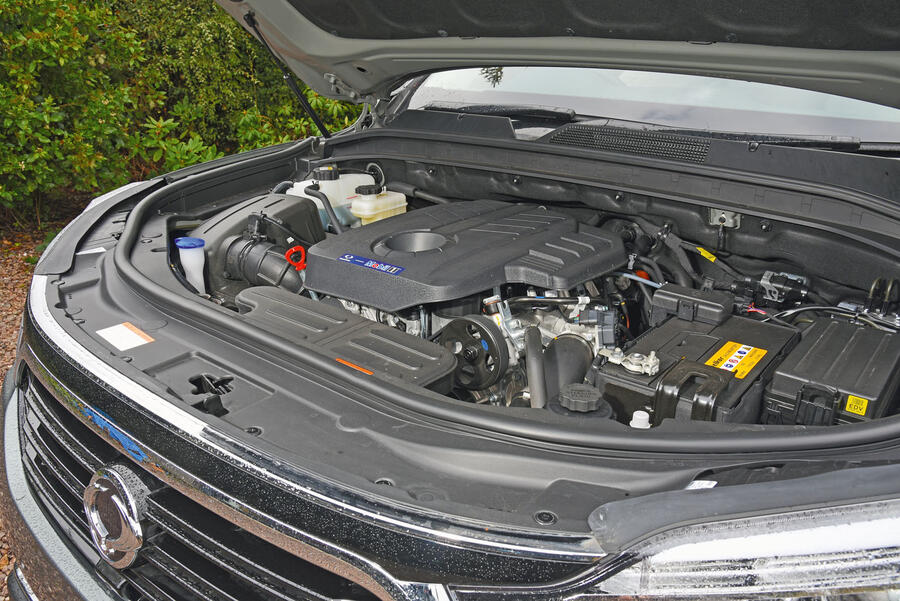
Life with a Ssangyong Rexton: Month 4
Our 4x4 workhorse is proving surprisingly tranquil to drive and practical to live with - 12th September 2018
Having thought that the Rexton would forever consume at least a gallon of diesel every 30 miles, and often noticeably more, I’m now surprised by it consistently breaking through the 30mpg threshold.
True, this is hardly economical in absolute terms – and the figure is aided by my driving it more languidly than I do most other cars – but this is undeniably an improvement, and perhaps may yet be bettered. It makes the occasionally obvious shortcomings of its olde worlde undercarriage easier to bear.
Mind you, a couple of friends clambered aboard the Ssangyong recently and both were impressed by the space and luxury of its cabin. I then waited for them to comment on its ride but neither did, although I’ve noticed over the years that most car users are surprisingly impervious to jerking suspension.
I wish I could say the same for myself, but as my colleague Steve Cropley also concluded, the Rexton’s ride forcibly diverts you from the conclusion that this is a very pleasingly furnished, tough and useful SUV that otherwise makes a strong case for itself. It’s also proving utterly reliable and fault-free, aside from the inability (most probably mine) to get the infotainment system to import my contacts from my smartphone.
So I have now done what blokes never want to do – look at the instructions – and discovered that despite the owner’s pack containing a handbook as thick as a headstone, the guide to the infotainment system occupies another volume that’s not in the car. So this will remain a mystery until I get one.
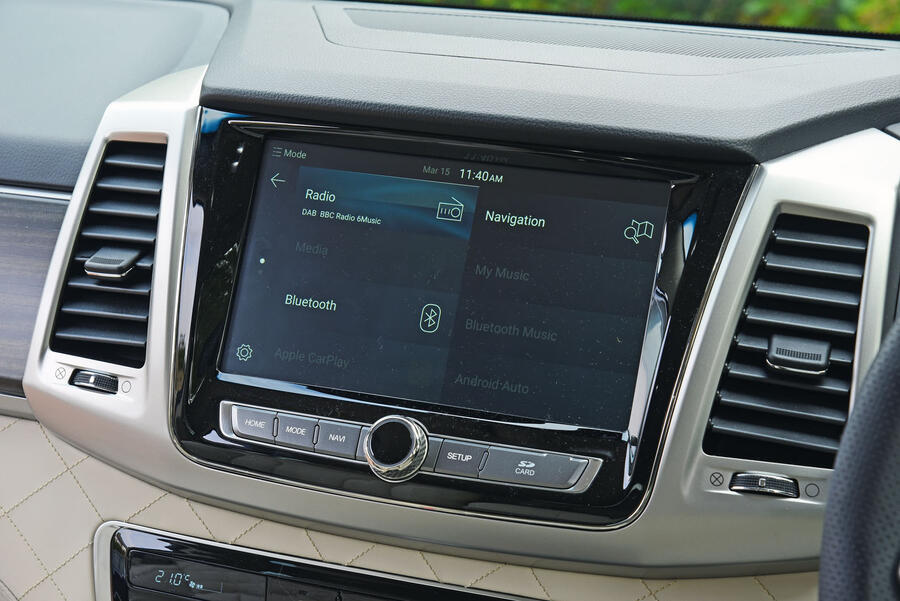
No need to delve into the big fat book to understand the facilities offered by the message display in the instrument cluster, however.
Operated from the steering wheel, it provides tyre pressure status, trip data, a digital speedo, nav directions and more, besides enabling you to adjust the car’s settings. These include the degree of tilt you wish each door mirror to perform when reverse is engaged, to the volume of assorted warnings.
You’ll be pleased to hear that the ‘computer-on, it’s a new dawn’ bongs confirming the obvious – you have opened your Rexton’s door; you have turned on its ignition – can be banished. Still, they’re not as irritating as the pretentious ‘Power Beauty Soul’ message that used to greet Aston drivers on start up, or assorted Mazdas texting dashboard hellos and goodbyes at you.
Am I getting curmudgeonly? Probably, but the Rexton will serenade you with plenty more bings and bongs if you drift from your lane, fail to buckle up or generally behave in a way that might undermine your right to sit behind the wheel. None of these was enough to prevent my reversing into a painfully solid object recently, so maybe I should shut up.
What doesn’t make much noise is the Rexton’s drivetrain, which is impressively quiet at a cruise. You can barely hear the diesel, or what must be substantial volumes of air being batted away by the Ssangyong’s big, bluff frontage.
That’s part of what encourages you to drive this car in the languid way previously alluded to, along with the high-altitude view, which sometimes allows you to see a lot more scenery than you otherwise would. And despite being reasonably well-endowed with seven Mercedes-made gears, the Rexton is not one for darting about, the transmission quite often allowing the engine’s revs to sink well off boost.
There’s no Sport mode, although you can flick your way through the gears via a little tab on the gearlever’s side. Better, though, to accept that the Rexton is the automotive equivalent of slow radio, enjoy the view out and indeed, the view in, such is the luxuriant ambience of its cabin.
Love it:
FEELSOME STEERING Driving a modern car with hydraulic power steering is a pleasing reminder of what ‘semi-real’ feel is.
Loathe it:
REAR RIDE QUALITY The ride in the rear is even stiffer than in the front and causes luggage to jiggle in the boot.
Mileage: 5661
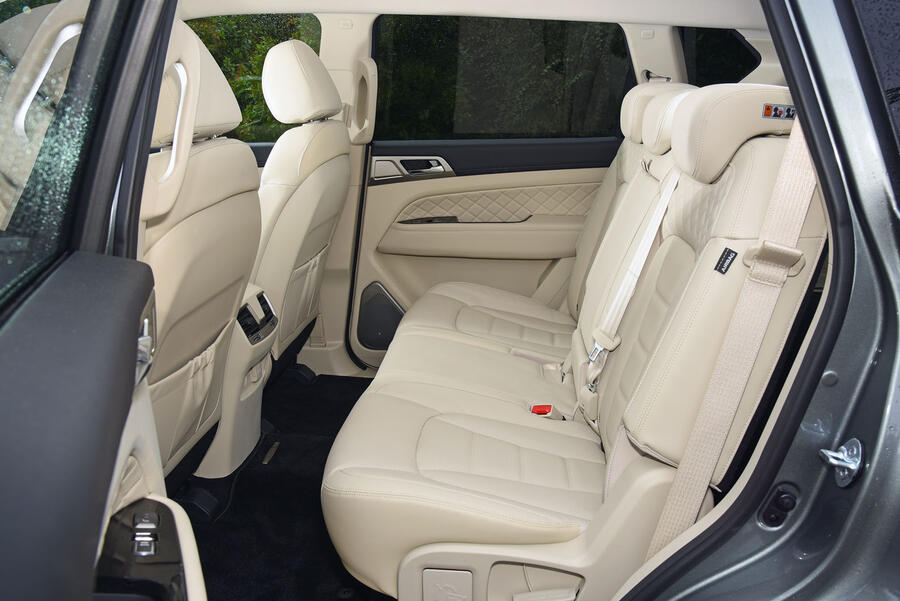
Clever use of diagrams on the instrument panel - 29th August 2018
A neat feature of the Rexton’s instrument panel is a profile graphic which uses animated illustrations to indicate whether any of the car’s six hinged body panels are open. So a door opens when you open it. Best is the power tailgate, with its rise illustrated in steps. It’s a fine example of what Ford used to call ‘surprise and delight’ features.
Mileage: 5570
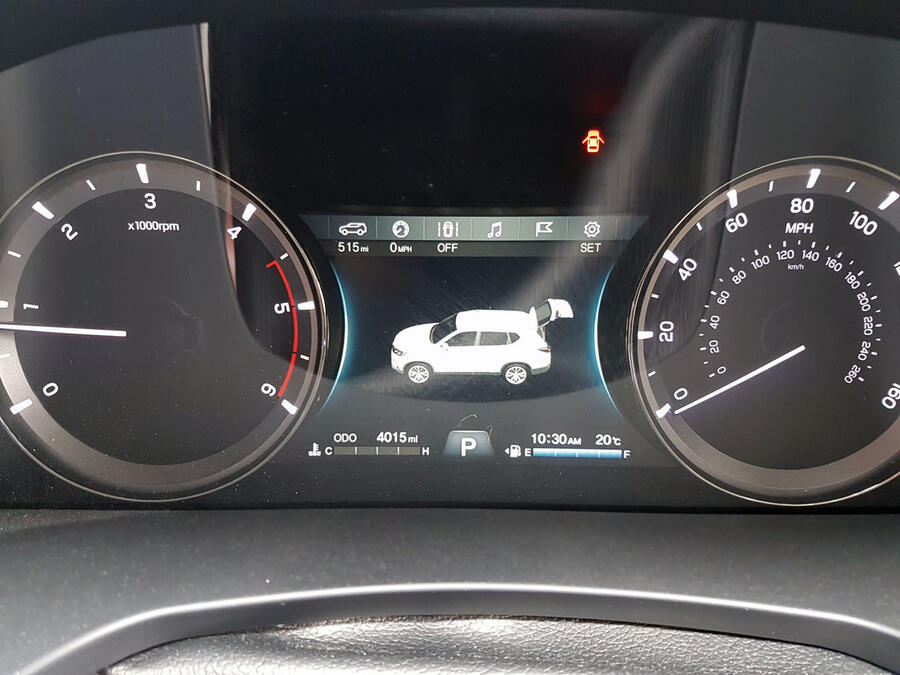
Life with a Ssangyong Rexton: Month 3
Our car is back on the road and helping another car follow suit - 15th August 2018
After the self-created calamity of reversing the Rexton into a driveway skip (a temporary resident, although that’s hardly an excuse), the big grey beast has at last returned, its repair delayed not by the difficulty of getting parts for so new a model but by insurance bureaucracy.
Gratifyingly, the Rexton looks none the worse for its driver’s stupidity, its return coinciding with the need to make a couple of long trips: one to Cornwall, another to the Lake District.
It has previously achieved such distances with little effort, if with an unsettling appetite for diesel that has easily dropped well below 30mpg. Since then, it has managed 31.3mpg (tank rather than trip computer measured) during trips long and short, and while that’s hardly brilliant for a diesel, it’s less mood-dampening than digits in the mid-20s.
And you can’t escape the fact that this car is big. Below you’ll see it in company with an orange Austin 1300 GT, a recent acquisition undergoing some refurbishment.
The Austin-Morris 1100/1300 was Britain’s top-selling car for the best part of the decade from 1962, and was effectively an enlarged Mini – and, like the smaller car, it packed an amazing amount of passenger space into its overall length. Its equivalent today would be a Ford Focus, itself a lot bigger than this 1300 but not as dwarfing as the Rexton.
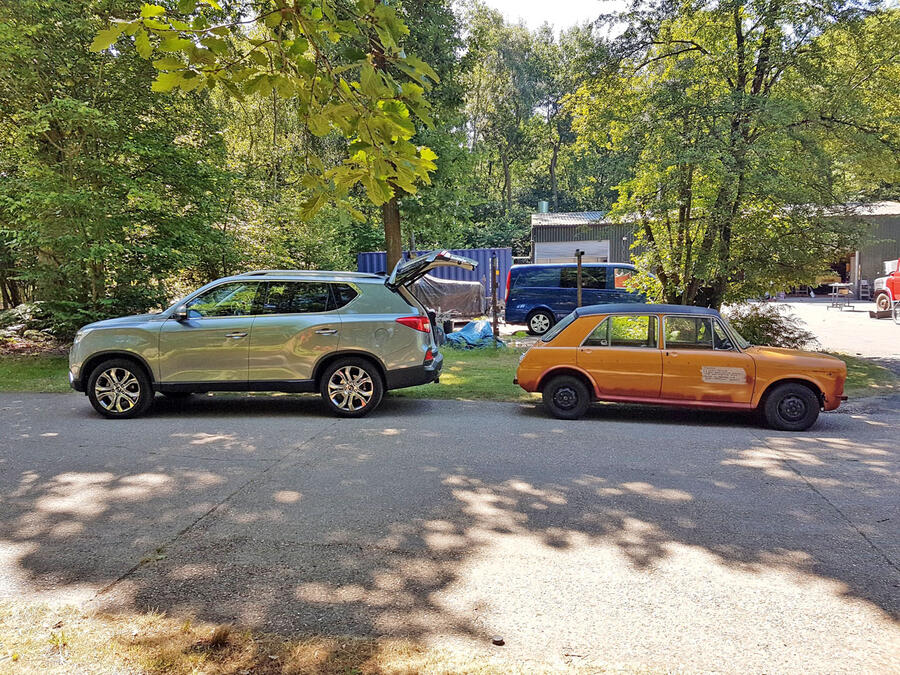
Of course, the two are barely comparable, but our parking bays and roads are increasingly filled with vehicles occupying a footprint similar to the Ssangyong’s. Still, the Rexton is an excellent machine for carrying a heap of tools, along with the dog kennel-sized, hose-festooned box that enables you to depressurise and reflate the Austin’s Hydrolastic suspension. At the end of this week, the Rexton will be carrying the new sills and front wing also needed, and when the Austin’s bodywork is finished, it will be towing the car home too. It’s a very useful vehicle.
And mostly relaxing too: the height of its seating puts you at ease, as does the quiet of its 2.2-litre diesel at a cruise. The Mercedes-sourced automatic is to be part-thanked for that, in fact: its seven speeds make it a lot easier to hide the engine’s higher rev harshness. What this ’box is less good at doing, however, is masking the quicksand-like torque hole below 1600 revs.
I’ve now been caught by this a few times when trying to dart onto a busy roundabout, either on the move or from rest. The pause before the turbocharger pumps hard quite often prompts your heart to do the same. When the surge finally arrives, you’ll probably find yourself urgently backing off – this the behaviour of 20th-century turbos.
The answer, you may be thinking, is not to drive the Rexton as if attempting to uncover the sports element of its SUV status, but you do get unexpected encouragement from the hydraulic power steering, which is surprisingly precise and weighted in a way that’s disappointingly rare these days. There’s also the fact that, up to a point, this big machine points into corners with more enthusiasm – relatively – than you’d expect.
It’s light years away from an early Discovery, for instance, as it should be, but if you can put up with the big-wheeled patter and thud, it can be made to get along a little more briskly than its dimensions imply.
Love it:
DECENT FRUGALITY The Rexton’s fuel consumption is improving, rising to 31.3mpg after recent trips.
Loathe it:
INDECENT RIDE The 4x4’s big wheels bump, thud and thump over most potholes.
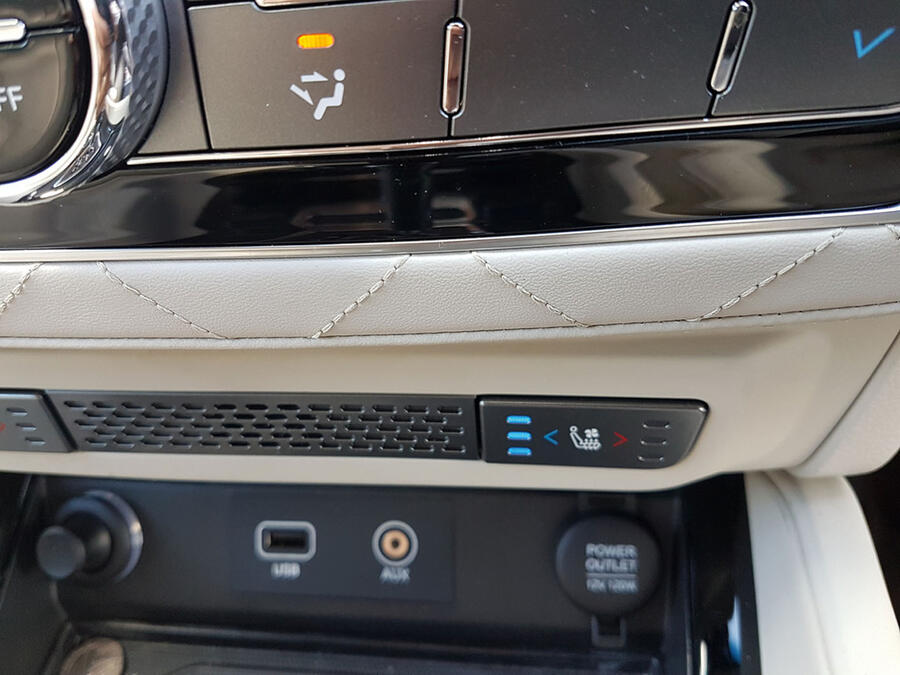
Mileage: 5323
Life with a Ssangyong Rexton: Month 2
Our big and burly 4x4 picked a fight with the wrong opponent - 23rd May 2018
Confession time: I recently failed to spot a skip while reversing.
This was in some ways a surprise at the time, because the skip was large, yellow and filled past its rim, making it decidedly visible. It was also in my drive, or to one side of it.
Despite this, and driver aids that include a reversing camera and parking sensors, I caught the side of the Ssangyong on the side of the skip, at the point where a chain is attached for lifting. The result was a big, button-like steel hook canopening the offside rear wing to excruciatingly noisy effect.
What made it worse was the need to drive the Rexton forward again to release it from the skip’s grasp, a manoeuvre that pulled one end of the bumper from its moorings.
The net result was damage to the inner and outer rear wing, the bumper, the wheel arch extension and the offside rear door. Not a good moment. It was Friday the 13th, but I’m not superstitious – just too cavalier with reversing in my own space, and forgetful of the skip.
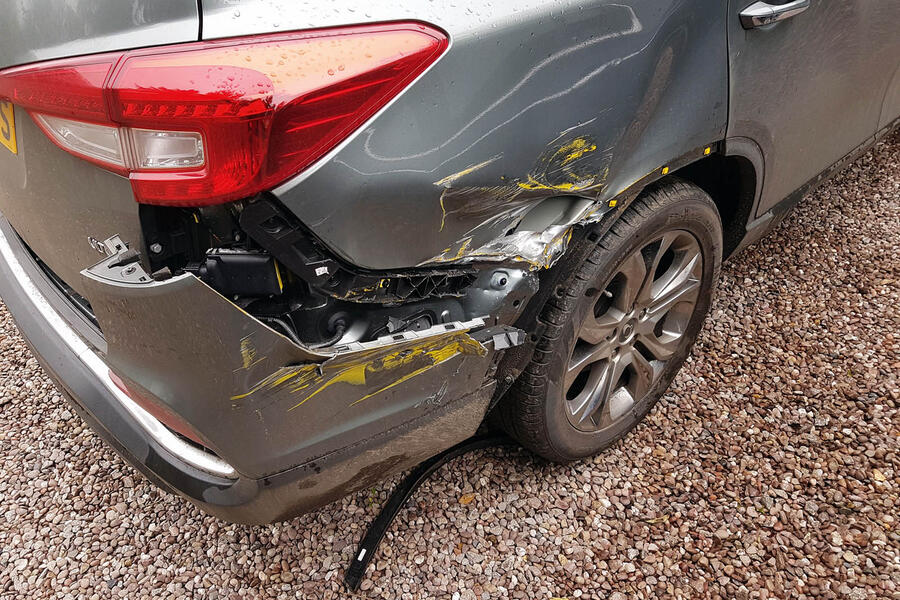
The Ssangyong is now back with its makers for repairs. It’s missed, not least for its sheer usefulness. It’s surprising how, once you have a vehicle this spacious, you discover loads you can carry that couldn’t easily be carried before... and now can’t because you have reshaped your wheels.
So, the Rexton wasn’t used for carrying a lawn mower for a service, nor collecting some wood, nor carting a very large ‘British Leyland’ ex-dealer sign that I plan to hang in my garage. Some of these are jobs it will do on its return, easily, because its seats-down load bay is vast.
Filling it will be that bit simpler because the Ultimate comes with a false floor that provides a flat deck, which is removable should you have a tall item to carry. If said tall item is also long, you can double-fold the rear seat, with the base forming a bulkhead and the backrests sitting lower as a consequence. It’s a useful, and safer, packaging arrangement that’s rare these days.
The Rexton’s interior may be part-furnished with ivory quilted leather, but there’s no question that it can play the beast of (major) burden. It’ll be intriguing to see whether filling its cabin smooths the ride. As previously mentioned, the Rexton’s ride is easily its weakest point, and it’s fortunate that it has many positives to make this worth putting up with if those plusses are valuable enough to you.
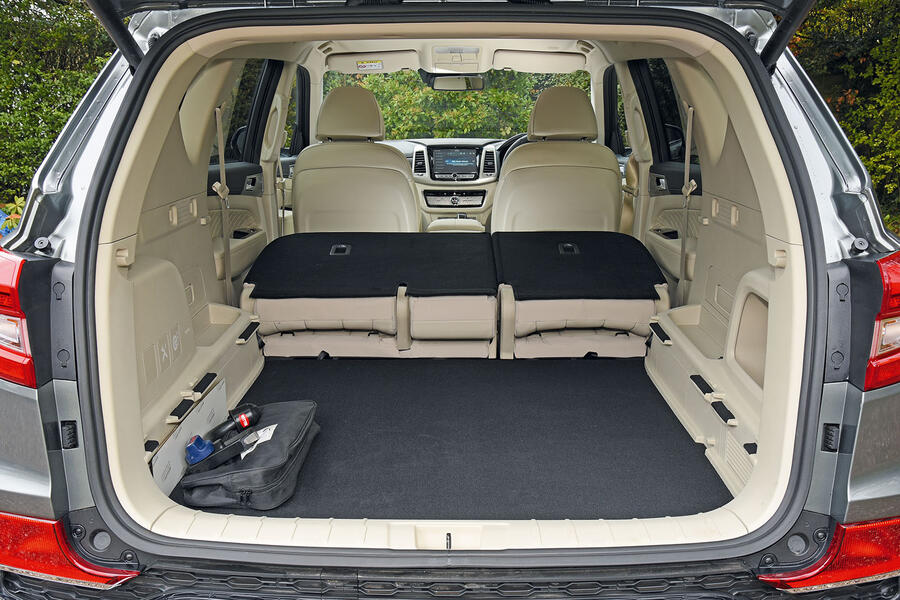
Apart from the Rexton’s space, these include its mostly smooth driveline, generous equipment, 2.5-tonne towing capacity, high-rise view out, luxuriant ambience, colourful infotainment system, attractive instruments (including message display zone), comfortable seats and very decent standards of fit and finish.
One of the less obvious pleasures is stepping into a cabin whose appearance is entirely at odds with Ssangyong’s lingering reputation for bargain-basement cars. The interior is anything but basement like, and while you wouldn’t quite call the Rexton’s price a bargain, it’s certainly good value and is not a car to generate the uncomfortable feeling that you have simply spent too little.
Love it:
CABIN AMBIENCE It feels, and is, more luxurious than you’d expect.
Loathe it:
THE ‘BLEEPING’ BLEEPS There are too many welcoming and warning chimes, of which more detail soon.
Mileage: 2230
Being unique on the roads - 9th May 2018
This is not a characteristic that the makers of the Rexton will likely enjoy, but there’s slightly foolish pleasure to be had from driving a vehicle an example of which you’re unlikely to see coming the other way. That’s partly because this Ssangyong is a new model, of course, but also because it’s a niche vehicle. For now, it’s a pleasingly rare beast.
Mileage: 2159
Life with a Ssangyong Rexton: Month 1
After an off-road experience to forget, is the SUV really as tough as it looks? - 25th April 2018
The mud-covered lanes where I live have rapidly given the Rexton a coat of filth not inappropriate to its rugged constitution. I plan to unleash a jet-washer on it soon, but there’s little point at the moment. And the dirt certainly provides a contrast to the Ssangyong’s pristine ivory cabin.
I quite enjoy the Range Rover-esque perversity of a vehicle that dunks itself in deepish puddles and drives out again, although I wonder how practical an ivory interior really is if you plan to off-road regularly.
Then again, a serious off-roader may not be daft enough to order a colour of this hue. And they’d also install rubber mats rather than the Rexton’s carpet overmats. In fact, it’s not mud that’s leaving traces on the upholstery but blue jeans, their dye already tinting the outer edges of the driver’s seat cushion.
This despite the fact that I try not to crush this bolster when getting in, because it’s massively vulnerable to wear given the Rexton’s height. It can be hard to avoid landing on it as you climb aboard, though. To remove the blue, I’ll be trying leather cleaner on it shortly.
Talking of off-roading, I indulged in a little burst while the Rexton was on its first photoshoot. It was a very short incline onto a road, from a track on a patch of grassy land, admittedly sodden with rain. To my amazement, the Ssangyong was unable to climb it in two-wheel drive, four-wheel drive or even low-range four-wheel drive.
Taking a modest run-up also failed to provide the momentum to crest this modest bank and hit the road. True, the mud had taken on the texture of a Nigella chocolate cake topping, but I thought low-range would be enough.
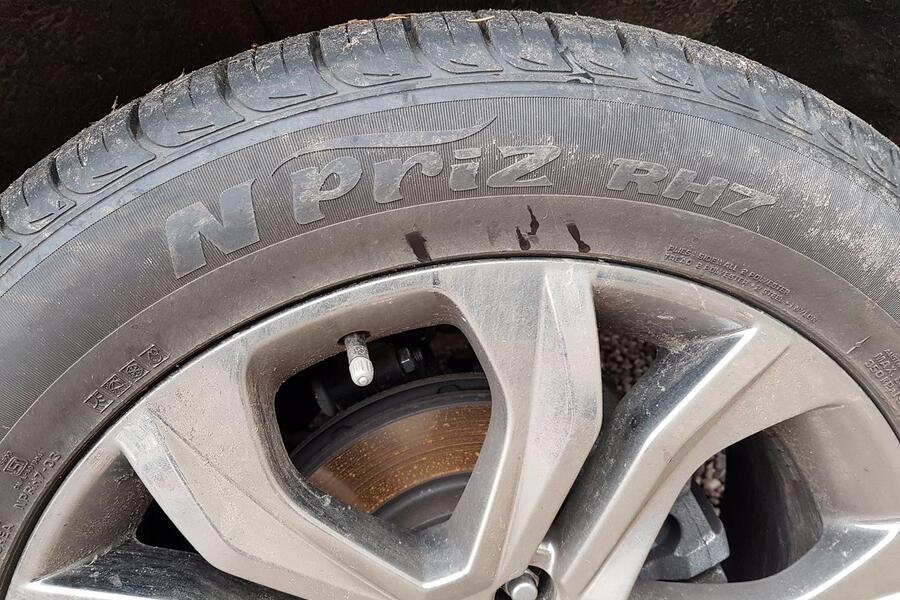
The cause of this muddy immobility was almost certainly the tyres. One thing I’ve learned over years of occasional serious off-roading is that without the right rubber, your electro-mechanical hardware will be struggling.
The tyres on this Rexton are Nexen N Priz RH7, and I assumed that they’d be summer tyres given this muddy nonperformance. But an inspection of the tyrewall revealed an embossed ‘M+S’, which means that they are actually mud and snow tyres – and that they ought to have done a bit of gripping.
Further off-roading is required to discover whether this mud was as slippery as wet floor polish and therefore less representative of the friction coefficient of most basic tracks, but it’ll be hard not to be tentative about departing metalled roads in case an embarrassing moment of stranding ensues.
While on the muddy theme – and this is the last point linked to the earthy gloop – it’s pleasing to see that the Ssangyong’s engine bay stays clean despite the 20in wheels occasionally hitting some big puddles to splashingly spectacular effect.
While there, I checked the Rexton’s oil and found it slightly overfilled, according to the dipstick. Maybe that’s affecting its fuel consumption, extra oil making it harder for the crank to pump pistons. Still, some better news on the economy score, which is that the trip computer appears to be pessimistic.
Up to 2151 miles, the Rexton has been achieving 31.6mpg, which is slightly better than the 29.7mpg registered last time with the computer alone.
You’re not going to win an economy marathon with figures like these, but the Rexton has yet to complete a really long trip, which usually yields better numbers. And it is, of course, an undeniably big and weighty beast.
It is also a likeable beast, further exposure doing nothing to diminish the pleasure of travelling in it. It’s mostly effortless, mostly quiet and mostly smooth, although it’s a little less smooth if you’re riding a B-road, where bumps sometimes discombobulate the relationship between suspension, chassis and body.
The steering is decently accurate and largely untroubled by these forces, reinforcing a relaxed demeanour that’s pleasing to live with despite such flaws.
Love it:
INTERIOR COMFORT We’re enjoying the cabin furnishings and the pretty comfortable driver’s seat.
Loathe it:
REAR-VIEW CAMERA The Rexton’s soon becomes sufficiently muck-covered to be of limited use.
Mileage: 2208
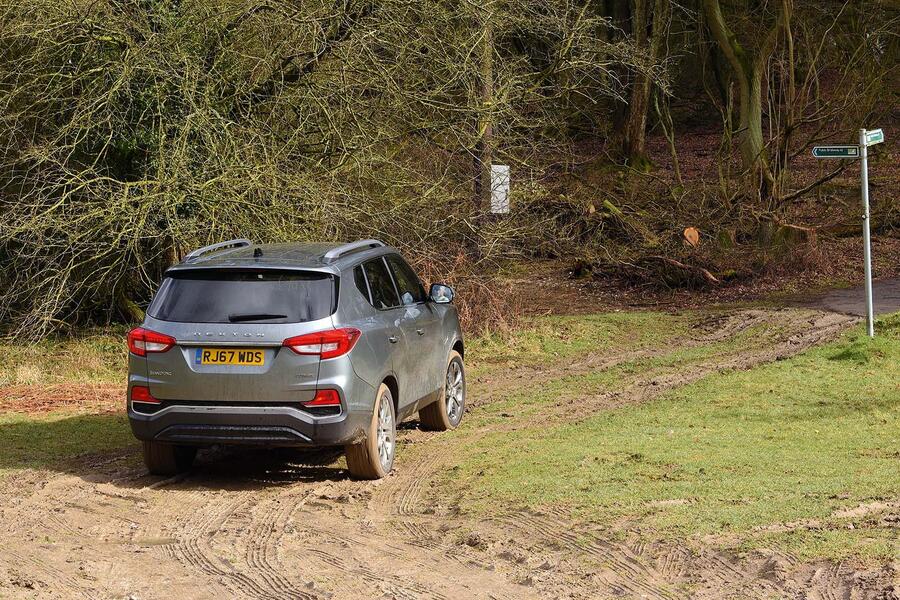
Rexton is proving an accommodating SUV in more ways than one - 11th April 2018
The Rexton’s seat heaters did much to blunt the chill of the recent Beast from the East.
The luxury of this suffusing warmth, and the complementary heated steering wheel, also compensated (slightly) for the discovery that it’s all too easy to see the trip computer’s estimation of your fuel consumption dropping below 30mpg.
I’d hoped that the running-in period – the Rexton arrived with just under 700 miles on the clock – might improve the 29.5mpg originally achieved. The Rexton has now done almost 2000 miles, and there has been a slight gain to 29.7mpg since, but I’m less optimistic now.
Still, these figures are less surprising when you consider the sizeable frontage the Rexton presents to the wind and the fact that it weighs more than 2100kg. And you can keep an eye on the trip computer, and the econometer, from a seat of some comfort, despite its surprising lack of a lumbar adjuster.
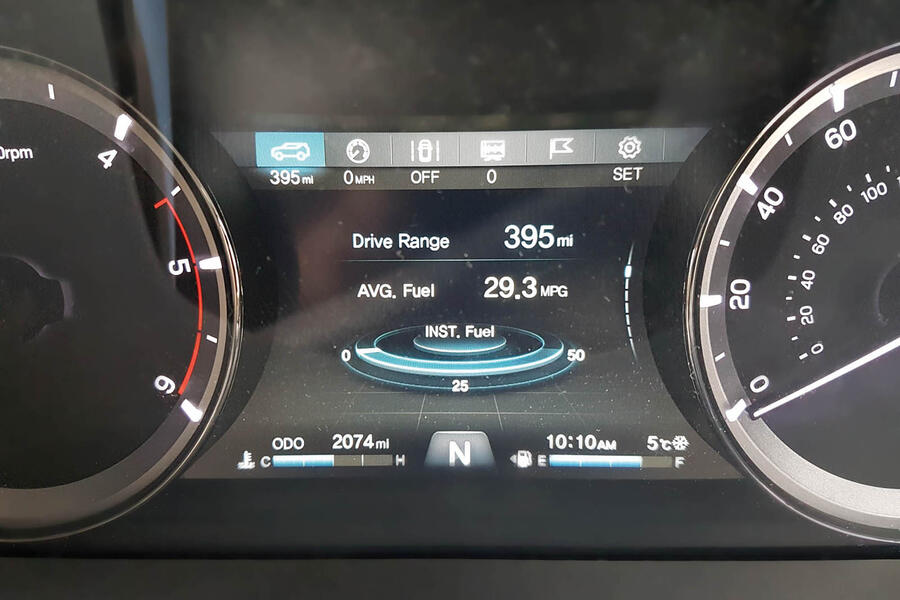
The Rexton is not an especially rapid machine (62mph arrives in a relatively leisurely 11.9sec) but that suits its demeanour, even if the aura of comfort can be rudely interrupted by the effects of a broken road surface. The suspension and separate chassis are sometimes jarring in their struggle to cope, and if the pothole is big and you’re aware of it, you’ll be circumnavigating the depression in question.
The Rexton hasn’t done any towing yet, but it has already been used to cart two lawnmowers simultaneously – with the car’s rear seats still in place – and it also helped with the clear-out of a flat. Our Ultimate version comes with a two-section false floor that eliminates the step between the underfloor and the folded backrests, but you can significantly expand the space by removing the sections, and tipping the entire folded rear seat forwards again.
This also has the advantage of providing a low bulkhead behind the front seats – highly desirable, noted the lawnmower repairman, when you are carrying large, bladed tools that might move during an emergency stop, or worse.
Besides mowers and mattresses, the Rexton has also carried friends, all of them impressed with both the finish of its interior and its space. None has yet commented on the sometimes jumpy ride, but perhaps they’re being polite. Their observations are usually easy to hear, because the Rexton’s drivetrain is pretty quiet. Its seven gears allow the diesel to spend most of its time spinning beneath 3000rpm, and to achieve a restfully subdued cruise on the motorway. Deploying kickdown briefly changes all that, the engine roaring with effort, but these moments are brief, unless you’re in a real hurry.
The hurried will also discover that the Rexton can be annoyingly slow off the mark when you’re pulling out of a junction, prompting a deeper sinking of the throttle that can then provoke a gravelly scrabble from the inside rear wheel. So it’s not always restful, and certainly not speedy.
You won’t be pushing it to the limit on back roads, either, although some experimentation on a gravel road induced an amusing little drift, curtailed by the stability control system. The Rexton runs in rear-wheel drive, incidentally, unless you select all-wheel drive or low range. So there’s scope for more serious offroad work.
For the moment, though, the Ssangyong is scoring points for its usefulness, cabin ambience and cruise-along character.
Love it:
ELEVATED VANTAGE POINT The cabin layout is almost entirely an ergonomic delight. Only the ease with which the hazard lights button can be knocked on detracts.
Loathe it:
FLAT-LINING ECONOMY Fuel consumption of 29.7mpg doesn’t look like it will improve much now the Rexton is run-in.
Mileage: 3133
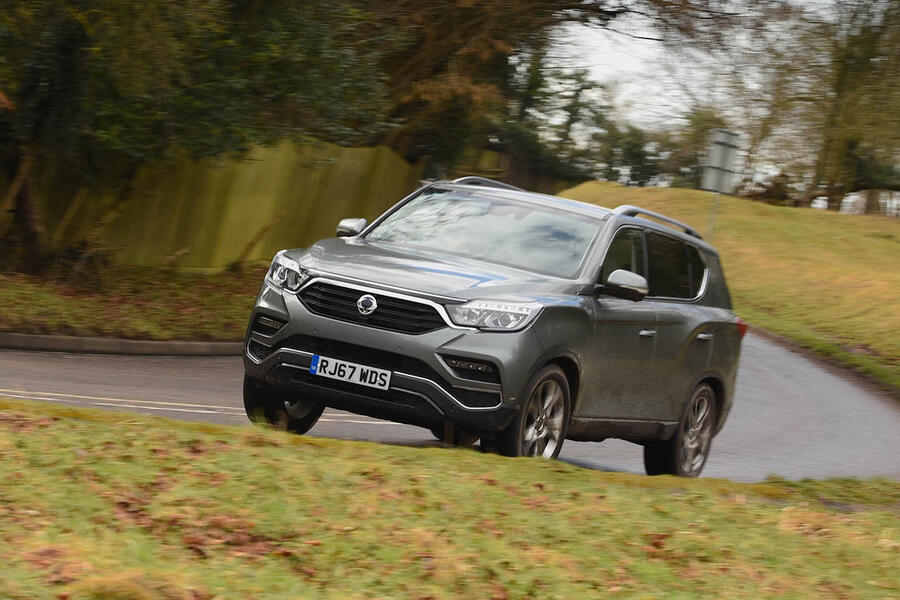
Welcoming the Rexton to our fleet – 28th March 2018
Whatever you think of Ssangyong, there’s no denying that the company’s new Rexton four-wheel drive is a vehicle of intriguing contrasts.
It has a finely appointed interior crammed with modern electrical tech, yet there’s an old-school rotary knob allowing you to switch between rear-wheel drive, four-wheel drive and low range. It has a rather 20th-century separate chassis, above which sits a modishly sumptuous quilted leather interior.
So this is your big, tough SUV in the form that most of these beasts used to come in, underpinned with box-section steel reinforcements that would have been familiar to Isambard Kingdom Brunel.
South Korean Ssangyong is now well into a recovery drive under the apparently benevolent wing of Mahindra & Mahindra, racing to catch up with competitors after bankruptcy protection and takeover. It’s also aiming to find itself a viable niche in a crowded automotive world. Rather than battle the major SUV makers head-on, the Rexton sits in an increasingly lonely slot occupied by rugged 4x4s with a separate chassis and the ability to tow 3.5 tonnes in sometimes arduous conditions.
Unless you’re happy to drive a crew-cab pick-up truck – indeed, the Rexton shares its foundations with just such a vehicle, in the shape of the new Musso – your only similarly constructed alternatives are the ageing Mitsubishi Shogun, the utility Jeep Wrangler, Toyota’s Land Cruiser or the Mercedes G-Class.
But as Ssangyong points out, there’s a market for a tough SUV that can play the mule, and the firm has ambitions to take a slice of it, aided by the fact that this much-improved Rexton provides equipment and furnishings that are entirely contemporary. So, all versions have autonomous emergency braking, forward collision warning, lane departure warning and traffic sign recognition, as well as Apple CarPlay and Android Auto, a rear-view camera, auto headlights and wipers and at least eight airbags, for a price that starts at £27,995.
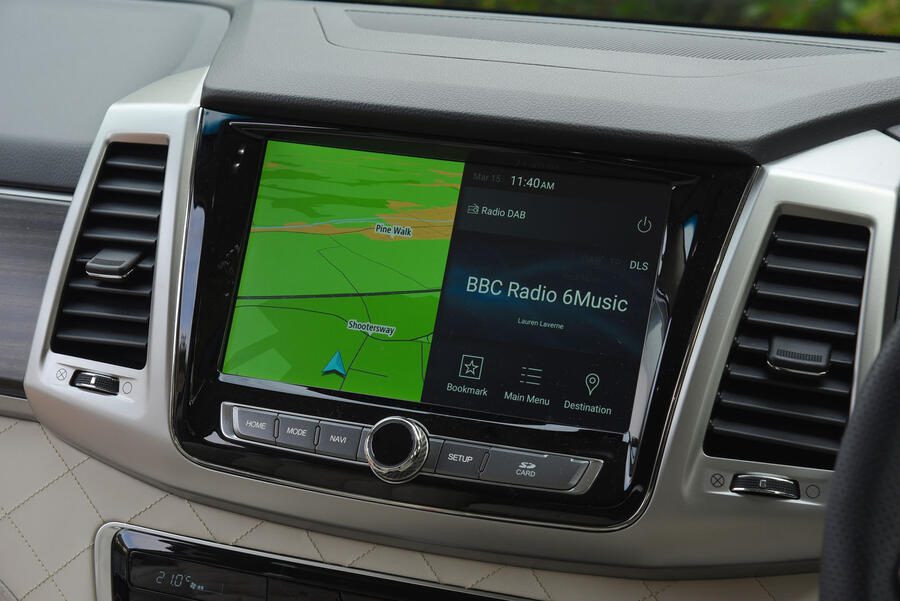
That gets you the EX trim; there’s also an ELX version, but we have greedily gone for the Ultimate, in no small part because it provides one of the Rexton’s biggest visual surprises. Which is a part-quilted, nappa leather interior redolent of a Bentley’s. Of course, close inspection soon shows why a Bentley cabin costs so much more – not because the Rexton’s is poorly finished, but because Bentley goes much further with detail like knurled metal gearlever knobs. Sit aboard the Rexton, though, and you’ll be enjoying a decently premium experience, if not a super-luxury one.
And the Ultimate certainly comes laden with kit. The front seats are ventilated as well as heated, the rear seats and steering wheel are heated, there’s an around-view monitor, a power tailgate, 20in alloys (in gangsta chrome finish), a removable false floor, a sizeable 9.2in infotainment screen, a driver’s knee airbag and, unusually, a 220V power supply – just the job for charging laptops and power tools.
The Rexton’s engine is the same regardless of trim, its 2.2-litre turbodiesel mustering 179bhp and a more promising 310lb ft of tugging power between 1600 and 2600rpm. The Rexton Ultimate comes with automatic transmission as standard, a seven-speed Mercedes E-Tronic gearbox (Ssangyong has a long association with Daimler). The less expensive versions are available with a six-speed manual.
The Ultimate also comes as a five-seater, but seven-seat Rextons are also available. If the seven-seat option implies plenty of space, well, there is – the five-seater providing 820 litres seats-up, or 1977 litres seats down. That can’t be far off the capacity of many a garden shed.
Such usefulness I plan to put to good use, along with the optional tow-hook, by using the Rexton to transport assorted non-running classic cars about and, in the case of a dismantled 1968 Alfa Romeo GTV currently undergoing a body restoration, a load of parts too. With that 3.5-tonne towing capacity, it should be a breeze.
And so far, so is living with the Rexton. When you climb into its cabin, your resultant height reminds you that all these new crossovers and SUVs do not ride as revealingly high. New vistas are opened up on familiar journeys because you can see over hedges, and often a lot further up the road too. You ride at the same regal height as you do in a Range Rover, and it’s very pleasant. That same height rather underlines the Rexton’s more limited on-road dynamic potential, although the steering is quick enough and furnished with unusually good feel, the assistance being hydraulic rather than electric. So it’s a bit more wieldy than separate-chassis SUVs used to be, but unsurprisingly well adrift of the athletic scope of a BMW X5.
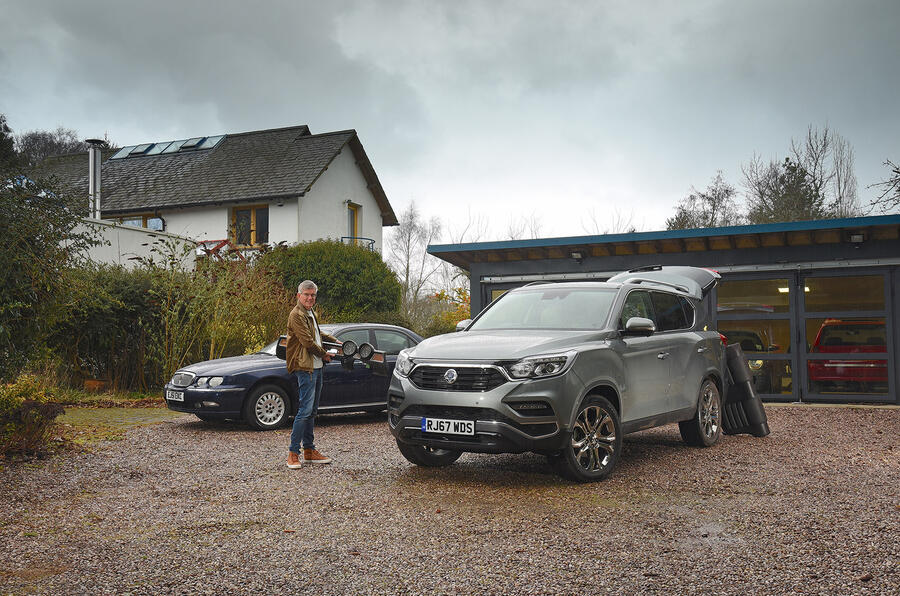
It’s not that kind of car, of course. But it presents well, if you can get past the rather weird sculpture of the front wings – and the fit, finish and robustness of our car are good. No rattles have been detected and, apart from a footling difference in panel gap between one side of the tailgate and the other, it’s a well-finished vehicle (car isn’t quite the word for this beast) both inside and out.
The next six months will tell us whether the Rexton’s now quite rare collection of trade-offs works, whether its liveable with daily and how good a tow it can muster. And we’ll be enjoying the voyage aboard a pleasingly upholstered cabin.
richard bremner
Second Opinion
This looks interesting as a cut-price Discovery. It is equipped for off-roading, has loads of space and comes with plenty of toys. Given the five-year warranty and uncertainty around residuals, buyers might be temped to get a cheaper one-year-old version with four years of guarantee left.
Will Williams
Ssangyong Rexton specification
Specs: Price New £37,995; Price as tested: £40,150; Options: Metallic paint £600, towbar and electrics £805, spare wheel kit £750
Test Data: Engine 4cyl, 2157cc, turbocharged diesel; Power 179bhp at 4000rpm; Torque 310lb ft at 1600-2100rpm; Top speed 115mph; 0-62mph 11.9sec; Claimed fuel economy 34.8mpg;Test fuel economy 29.5mpg; CO2 218g/km; Faults None; Expenses None
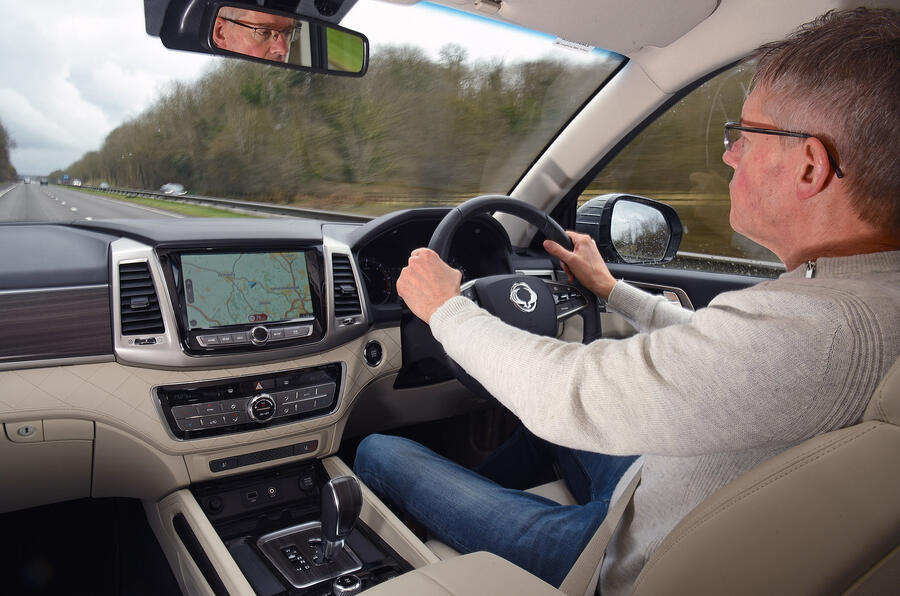
Comments
Post a Comment